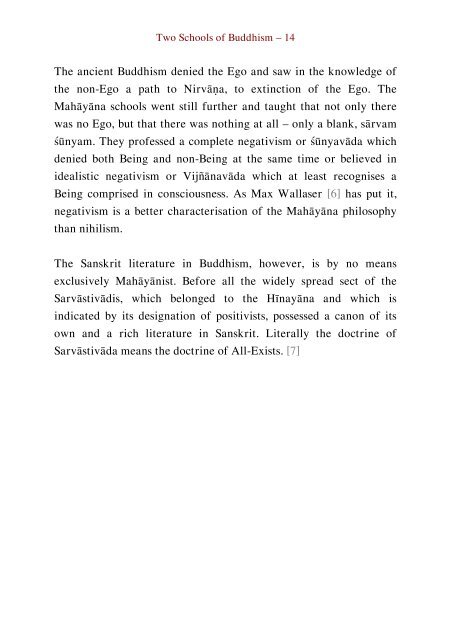- Page 2 and 3: 1 Literary History of Sanskrit Budd
- Page 4 and 5: 3 Translation into Chinese and Tibe
- Page 6 and 7: 5 Chapter 7: Mahāyānasūtras Wors
- Page 8 and 9: 7 The aspirant’s obligations Self
- Page 10 and 11: 9 Preface What follows is the first
- Page 12 and 13: 11 Chapter 1: Two Schools of Buddhi
- Page 16 and 17: 15 Chapter 2: Sanskrit Buddhist Can
- Page 18 and 19: Sanskrit Buddhist Canon - 17 transl
- Page 20 and 21: 19 Chapter 3: Mahāvastu As belongi
- Page 22 and 23: Mahāvastu - 21 3), lastly recounts
- Page 24 and 25: Mahāvastu - 23 Its Jātakas Quite
- Page 26 and 27: Mahāvastu - 25 Inferno as well as
- Page 28 and 29: Mahāvastu - 27 Suttanipāta. When,
- Page 30 and 31: Lalitavistara - 29 of the Buddha.
- Page 32 and 33: Lalitavistara - 31 light expands it
- Page 34 and 35: Lalitavistara - 33 episodes in part
- Page 36 and 37: Lalitavistara - 35 an anonymous com
- Page 38 and 39: Lalitavistara - 37 and Bloch Zeitsc
- Page 40 and 41: 39 Chapter 5: Aśvaghoṣa and his
- Page 42 and 43: Aśvaghoṣa and his School - 41 Ac
- Page 44 and 45: Aśvaghoṣa and his School - 43 An
- Page 46 and 47: Aśvaghoṣa and his School - 45 Th
- Page 48 and 49: Aśvaghoṣa and his School - 47 Ju
- Page 50 and 51: Aśvaghoṣa and his School - 49 le
- Page 52 and 53: Aśvaghoṣa and his School - 51 Va
- Page 54 and 55: Aśvaghoṣa and his School - 53 Ta
- Page 56 and 57: Aśvaghoṣa and his School - 55 So
- Page 58 and 59: Aśvaghoṣa and his School - 57 il
- Page 60 and 61: 59 Chapter 6: Avadāna The Jātakam
- Page 62 and 63: Avadāna - 61 these species of avad
- Page 64 and 65:
Avadāna - 63 This process of worki
- Page 66 and 67:
Avadāna - 65 Maiden Disciple: Stor
- Page 68 and 69:
Avadāna - 67 Buddha. This narrativ
- Page 70 and 71:
Avadāna - 69 our printed edition (
- Page 72 and 73:
Avadāna - 71 story of Śārdūlaka
- Page 74 and 75:
Avadāna - 73 Triśanku; and who el
- Page 76 and 77:
Avadāna - 75 Pūrṇa who goes out
- Page 78 and 79:
Avadāna - 77 legends in these Avad
- Page 80 and 81:
Avadāna - 79 verse, again Pāḷi
- Page 82 and 83:
81 Chapter 7: Mahāyānasūtras [64
- Page 84 and 85:
Mahāyānasūtras - 83 out into a f
- Page 86 and 87:
Mahāyānasūtras - 85 delighted an
- Page 88 and 89:
Mahāyānasūtras - 87 Exaggeration
- Page 90 and 91:
Mahāyānasūtras - 89 reproach for
- Page 92 and 93:
Mahāyānasūtras - 91 Age of the S
- Page 94 and 95:
Mahāyānasūtras - 93 world fashio
- Page 96 and 97:
Mahāyānasūtras - 95 His peregrin
- Page 98 and 99:
Mahāyānasūtras - 97 which are co
- Page 100 and 101:
Mahāyānasūtras - 99 Kāruṇāpu
- Page 102 and 103:
Mahāyānasūtras - 101 Samādhirā
- Page 104 and 105:
Mahāyānasūtras - 103 fragment of
- Page 106 and 107:
Mahāyānasūtras - 105 thousand ś
- Page 108 and 109:
Mahāyānasūtras - 107 denied, - e
- Page 110 and 111:
109 Chapter 8: Nāgārjuna [89] The
- Page 112 and 113:
Nāgārjuna - 111 entire system of
- Page 114 and 115:
Nāgārjuna - 113 were executed and
- Page 116 and 117:
Nāgārjuna - 115 (Haraprasad Shast
- Page 118 and 119:
Nāgārjuna - 117 Asaṅga Asaṅga
- Page 120 and 121:
Nāgārjuna - 119 The commentary sh
- Page 122 and 123:
Nāgārjuna - 121 For other authori
- Page 124 and 125:
Nāgārjuna - 123 because Śāntide
- Page 126 and 127:
Nāgārjuna - 125 the salvation of
- Page 128 and 129:
Nāgārjuna - 127 Some of the passa
- Page 130 and 131:
Nāgārjuna - 129 precepts of good
- Page 132 and 133:
Nāgārjuna - 131 109 ff.). Still i
- Page 134 and 135:
Strotras, Dhāraṇīs, Tantras - 1
- Page 136 and 137:
Strotras, Dhāraṇīs, Tantras - 1
- Page 138 and 139:
Strotras, Dhāraṇīs, Tantras - 1
- Page 140 and 141:
Strotras, Dhāraṇīs, Tantras - 1
- Page 142 and 143:
Strotras, Dhāraṇīs, Tantras - 1
- Page 144 and 145:
Strotras, Dhāraṇīs, Tantras - 1
- Page 146 and 147:
Strotras, Dhāraṇīs, Tantras - 1
- Page 148 and 149:
147 Appendix II. Sūtrālaṅkāra,
- Page 150 and 151:
Sūtrālaṅkāra - 149 himself to
- Page 152 and 153:
Sūtrālaṅkāra - 151 that the Eu
- Page 154 and 155:
Sūtrālaṅkāra - 153 The Nationa
- Page 156 and 157:
Sūtrālaṅkāra - 155 Life of Aś
- Page 158 and 159:
Sūtrālaṅkāra - 157 the age of
- Page 160 and 161:
Sūtrālaṅkāra - 159 open, activ
- Page 162 and 163:
Sūtrālaṅkāra - 161 sacrifice t
- Page 164 and 165:
Sūtrālaṅkāra - 163 Sanskrit. I
- Page 166 and 167:
Sūtrālaṅkāra - 165 has so ofte
- Page 168 and 169:
Sūtrālaṅkāra - 167 The unident
- Page 170 and 171:
Sūtrālaṅkāra - 169 is the repu
- Page 172 and 173:
Sūtrālaṅkāra - 171 Maheśa ren
- Page 174 and 175:
Sūtrālaṅkāra - 173 domesticati
- Page 176 and 177:
Sūtrālaṅkāra - 175 His renowne
- Page 178 and 179:
Sūtrālaṅkāra - 177 mentioned i


















